This week we continue our travelogue series to cover my 2019 Complete Namibia Tour & Workshop, as we leave the deserted diamond mine town of Kolmanskop, for an afternoon in another deserted mine at Elizabeth Bay.
Unlike Kolmanskop, which is deteriorating relatively gracefully, the buildings at Elizabeth Bay were built using bricks made with seawater, so the salt is causing the bricks to erode away quicker than the mortar that holds the walls together. You can see this in action at the far end wall of these laborer’s quarters. On the other side of that wall
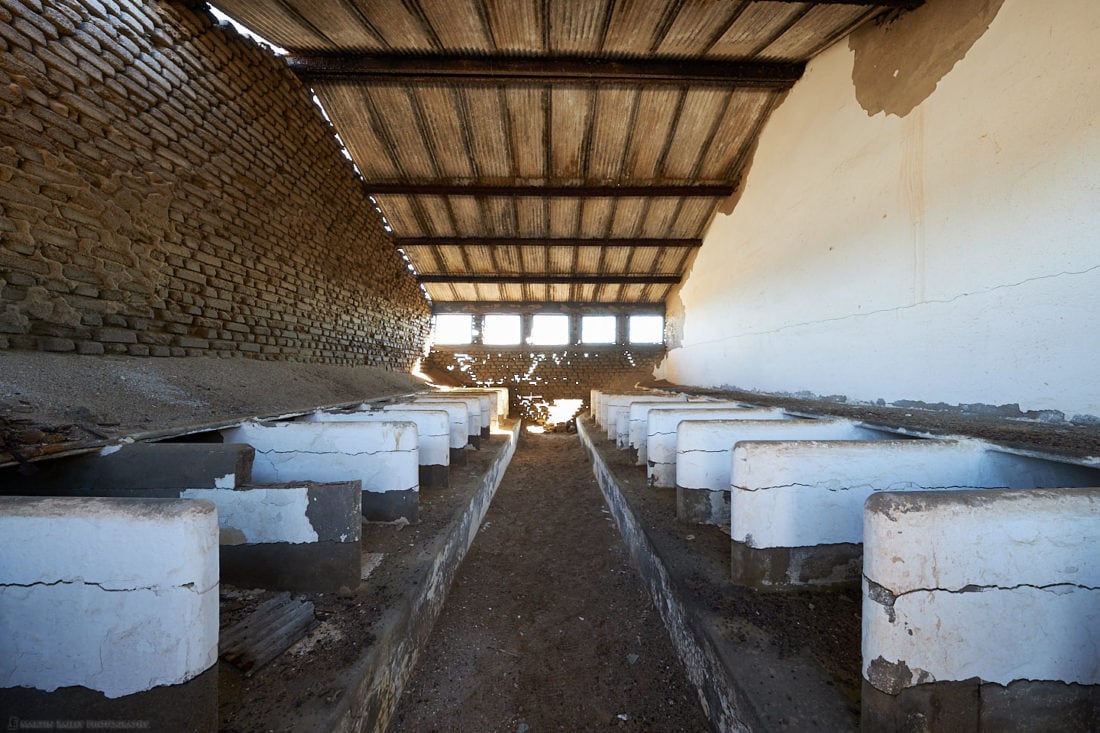
Once again, I used my favorite one-point perspective for this shot, aligning the far end of the building square on to the camera, as I find this increases the tension in the shot, and these rooms lend themselves to that in my opinion. I find it ironic that people that were reportedly making good money slept in such meager quarters, and probably left what little belongings they brought with them on that plate above the bed areas, only to be replaced by the dust of the crumbling plaster from the walls that once sheltered them from the sea winds. My settings for this photo were f/14 for 0.6 seconds at ISO 100, and I was using my Canon EF 11-24mm lens at 12 mm.
Crumbling Buildings
This next shot is more for documentary purposes, but I wanted to show you what some of these houses look like from outside. As you can see, the bricks are fairing the weather much worse than the mortar, and many of the buildings are simply collapsing as the bricks fail to support them. Because of this, we are obviously careful about which buildings we go inside. Needless to say, I didn’t feel comfortable venturing inside of this one.

Now outside, I was able to increase my shutter speed to a 1/50 of a second for this shot, but left my aperture at my favorite f/14 and ISO at 100, with my focal length adjusted to 20 mm.
Painted Palmtrees
Although the back of the next house I visited is crumbling pretty badly, it’s worth venturing in, as this is the building that Freeman Patterson photographed and used a photo similar to this on the cover of his Odysseys book.
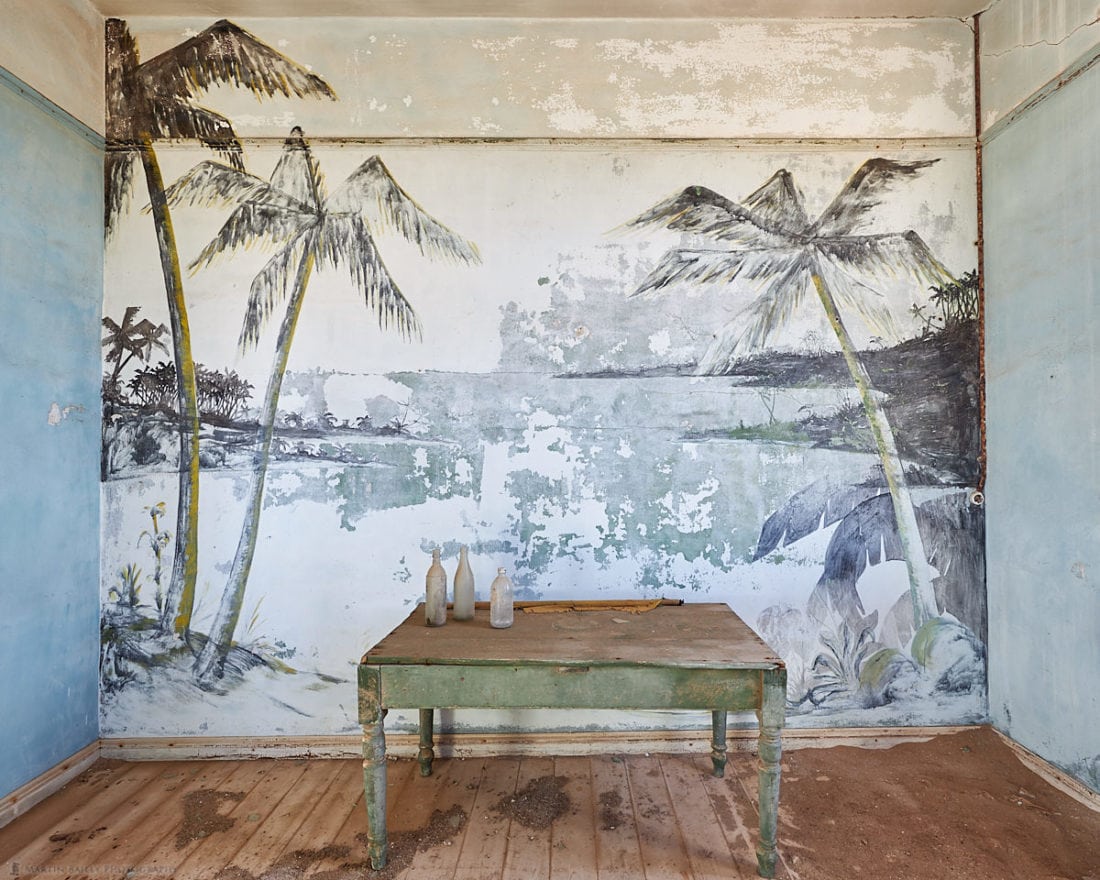
I cropped this to a 4:5 aspect ratio, to remove the windows to the right and the door to the left. I’ve shot it with them in the past, but figured I’d just concentrate on the wall and the table with the bottles this year. Back inside for this, my shutter speed was 0.5 seconds, and my focal length was 15 mm, with the rest of my settings unchanged.
Corroded Luderitz Jetty
Following an afternoon in Elizabeth Bay, we drove back to Luderitz, and a few of us got out of the vehicle a short walk from the hotel, to photograph the corroding jetty that you see in this next image. I look at this every year, but there was a bit of color forming in the sky on this evening, so I figured it would be a good opportunity to do some long exposure work to smooth over the sea and allow the clouds to move a little.
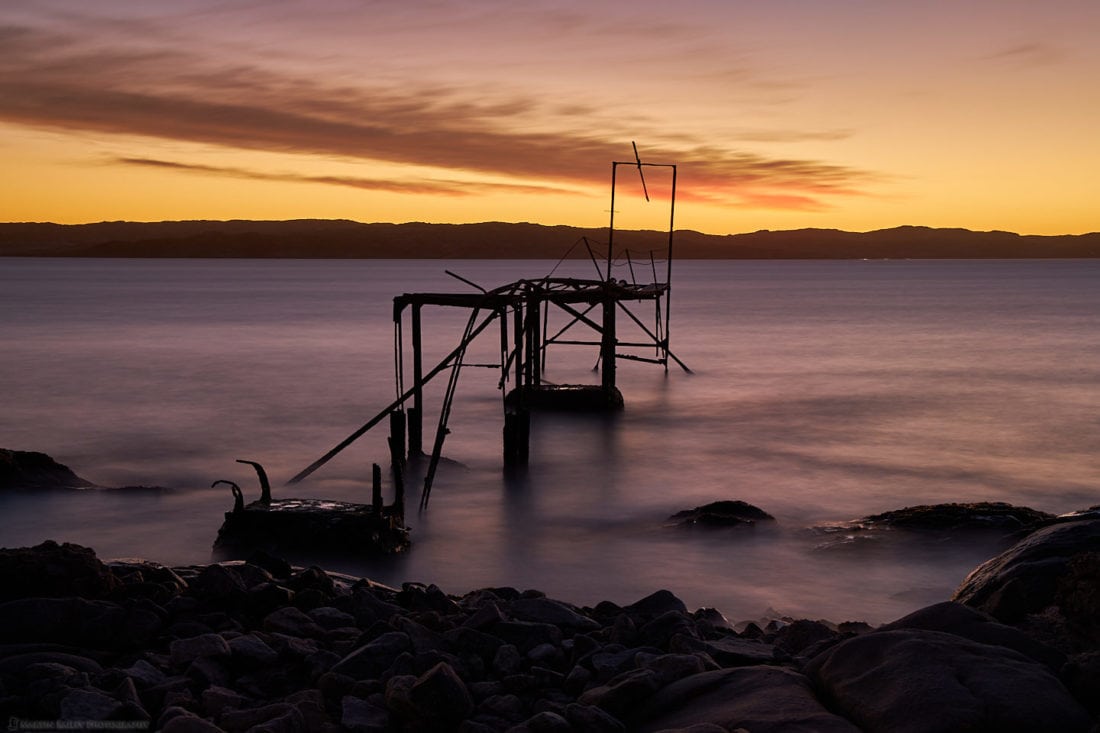
I shot from a few different angles, but prefer this one, as for some reason I really like those bent over metal spikes on the block in the bottom left. The rest of the structure is also severely corroded, and I don’t imagine this will be there for many more years, with some of those beams looking as though they’re going to fall away at any time.
If I recall correctly, I was using a six-stop neutral density filter, which took around a 0.5-second exposure out to one minute to capture the movement of the waves and sky. I was also carefully applying downward pressure on my tripod because the wind was blowing quite strongly, and my camera would have moved otherwise. I actually opened up my aperture to f/10 for this shutter speed too, as I didn’t want to risk going any longer while applying pressure. My focal length was 47 mm, now shooting with my Canon RF 24-105mm lens.
Deadvlei Silhouettes
The following morning we started one of our long drive days, which is a great way to see Namibia, and the roads are now much better than they were when I first
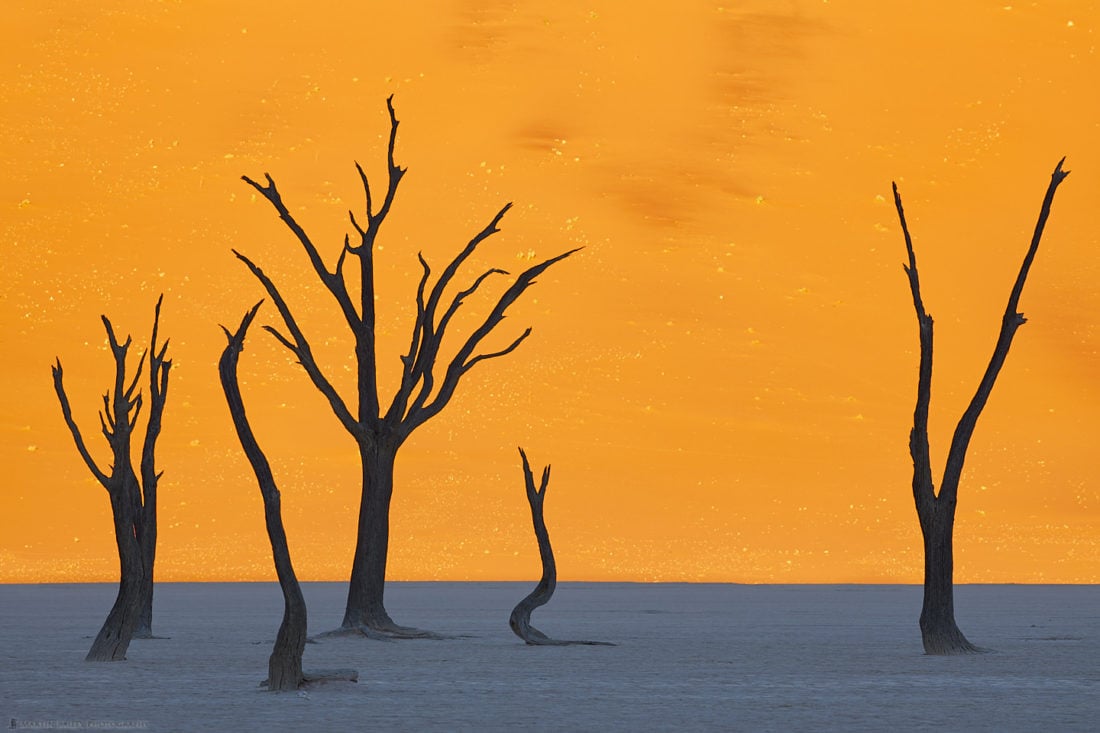
I’m sure you’ve seen this sort of image before, but I still love shooting these, and the magic never seems to fade as the sun climbs, illuminating the sand dune, but the shadow of the dune to our backs keeping the clay-pan and foreground camel thorn trees in the shade, making them almost silhouettes. It’s really hard to find something new when there are limited trees that can be framed up with adequate separation between them, but this year, I decided for my first shot that I’d allow the two trees to the left to overlap, so that I could put all five of them in that group on the left, and this makes me feel like there is a priest on the right, giving them a sermon, although he might also be holding up two fingers, making a peace sign.
My settings were ISO 100 for 1/25 of a second at f/14, and I was using my Canon EF 100-400mm lens at 200 mm. I find that longer focal lengths are essential to get separation between the trees because a wider angle includes other trees too easily. The sun only illuminates the background dune perfectly like this for a few minutes, so once I have a couple of frames of each composition, I run between a few other possibilities. On this morning I got five or six shots that I was really happy with, although I won’t share them all today.
Bands of Color
One other thing that I do like to do is to play with the bands of colors that form as the sun climbs, as we can see in this image, with the blue sky, darker dune, orange dune, a slither of brightly lit clay, then the clay basin still in shadow with the camel thorn trees.

The fun thing about this shot is that it actually shows you how much the trees in the previous image that we looked at were compacted. The three trees on the far right of this image are the third, fourth and fifth trees from the left in the previous image. The tree in between the other two trees just to the right of the center of this shot, is the tree on the right side of the previous image, and the tree that is overlapping the smaller tree in the third group from the left here is the back tree of the two on the left of the previous image.
You really wouldn’t think that they were as spaced out
Deadvlei Sand Storm
After our morning shoot in Deadvlei, we drove back to our lodge and got lunch, then after a little bit of downtime, we went back out and took a walk across the plain to photograph one of the sand dunes. We do this again at the end of the second day in the park, so I’ll share a photo from that shoot later, but before that, I’d like to share a couple more shots from Deadvlei from our second visit.
As we left the lodge on our second morning, there was a good wind blowing, and it got gradually stronger as the sun came up while we were waiting for that magic minute in Deadvlei. Having decided on our first composition, as we sat and waited for the silhouettes to form, every so often a strong gust of wind would whip up the sand and dust so much that it almost completely whited-out the background, so that the orange color of the background dune became almost a very pale pinkish-orange, as you can see here.
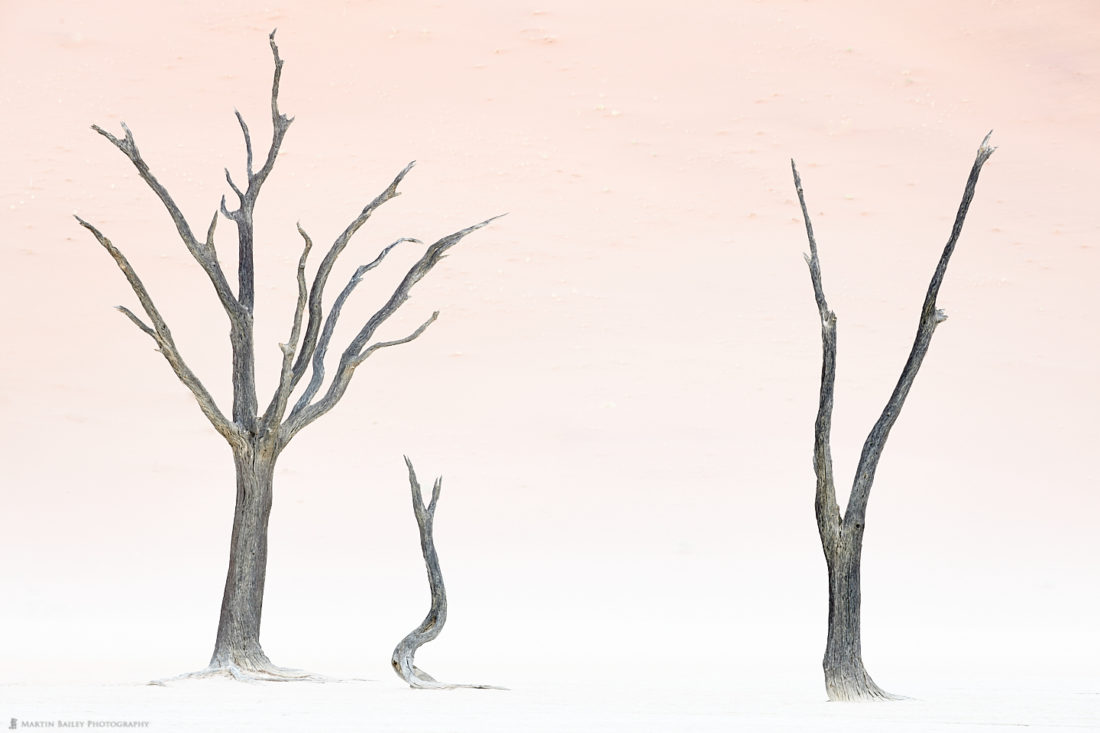
I like this because I’ve never seen shots like this from Deadvlei, so we had been presented with something very special, almost as if it was in payment for us being sand-blasted every few minutes. There were a few relatively uncomfortable moments as banks of sand swept through Deadvlei, but when they give you shots like this, it’s absolutely worth it. I also really like how the texture of the trees is so much more visible in these shots, and that soft colored background is a beautiful additional element. My settings for this image were ISO 100 for 0.8-seconds at f/14 and a focal length of 312 mm.
Stark Contrast
Also, to illustrate the stark contrast between the white background image and our main objective, here is the exact same photograph around 40 minutes later, as the sun reached the bottom of the background sand dune, increasing the contrast once again.
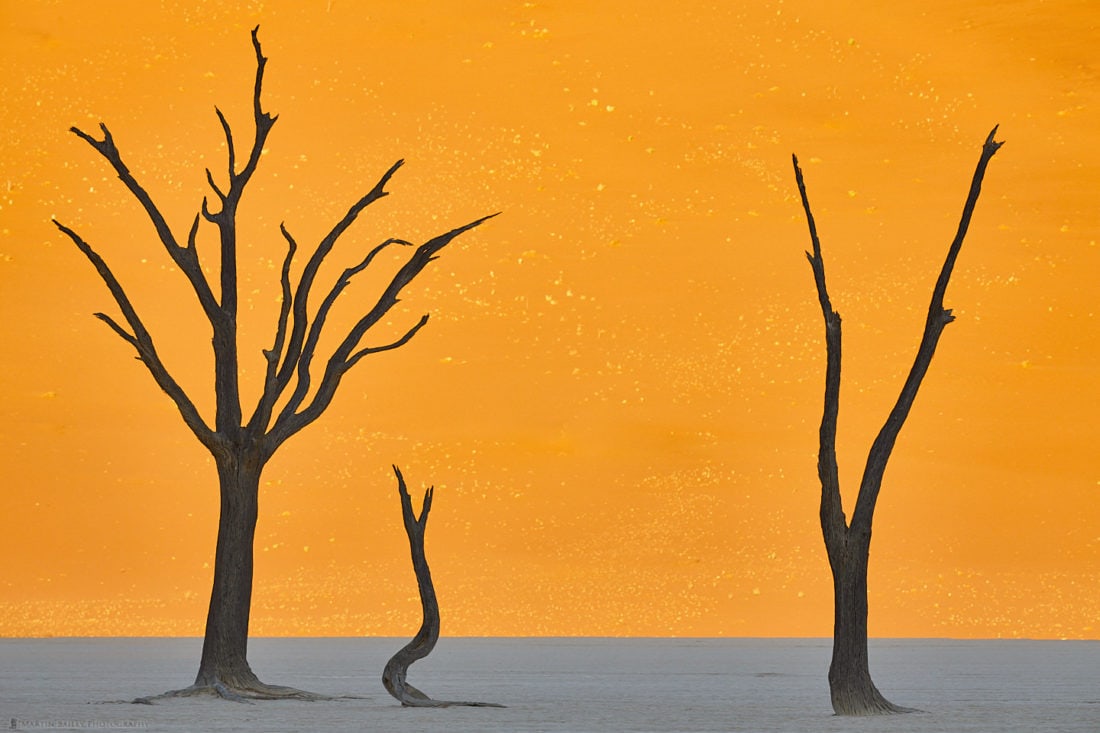
These three trees are the same as the right three in the main photo from the previous day, and I’ve shot this same composition many times now, but I do enjoy having this image from various cameras, and I have to say that this version from my Canon EOS R camera is absolutely stunning when viewed at 100%. My settings for this were
Smoking Dune
I’d like to share one last shot from Deadvlei before we move on. Once again, the high winds presented us with another unexpected bonus, as the sand from the brow of the sand dune that causes the shadow in the valley was backlit by the low morning sun, looking almost like the corona coming off of the surface of the sun itself.
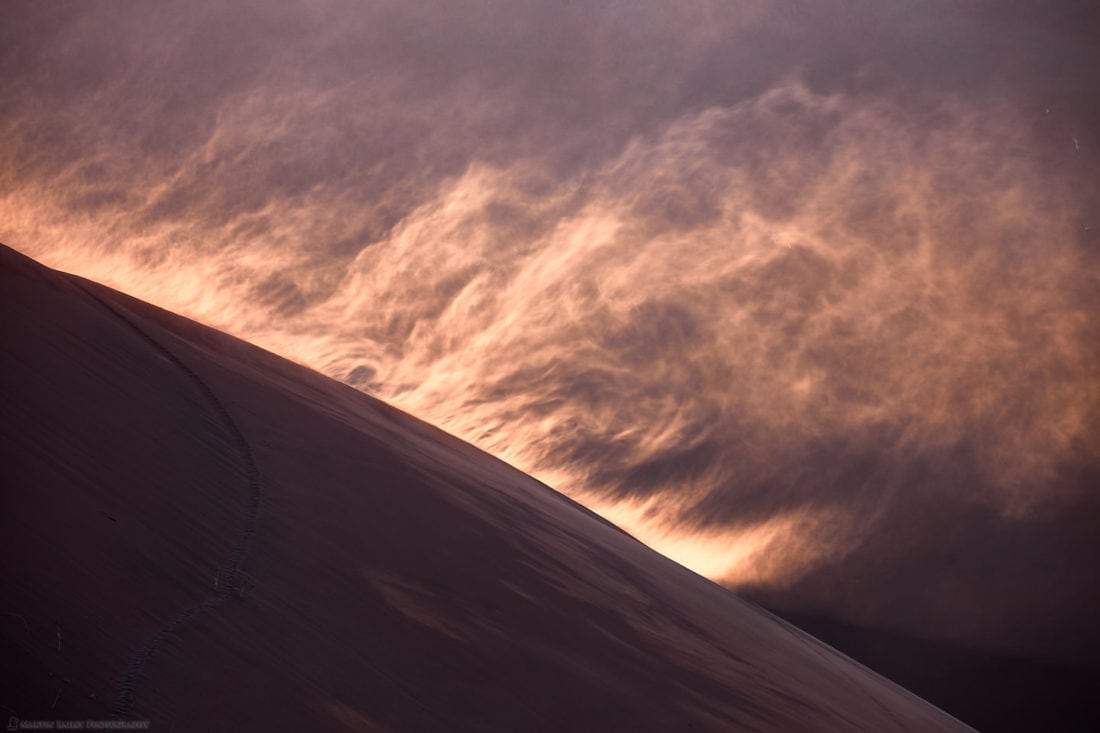
I’ve processed this to increase the contrast, using the tone curve and levels sliders to darken down the sand, allowing the smoking sand to look like fire, but there is still enough texture in the sand to see what it is. My settings for this shot were ISO 100 for a 1/50 of a second at f/11, and a focal length of 360 mm.
Fiery Sand Dune
As I mentioned earlier, we repeated the previous day, by driving back to our lodge for lunch, and after a bit of downtime headed out to walk to the face of a sand dune, and here you see it looking almost a fiery red with the last moments of sunlight before the sun went down. The wind is blowing the sand around the surface of the dune here, and of course, the contrast between the East and West sides of the dune causes the
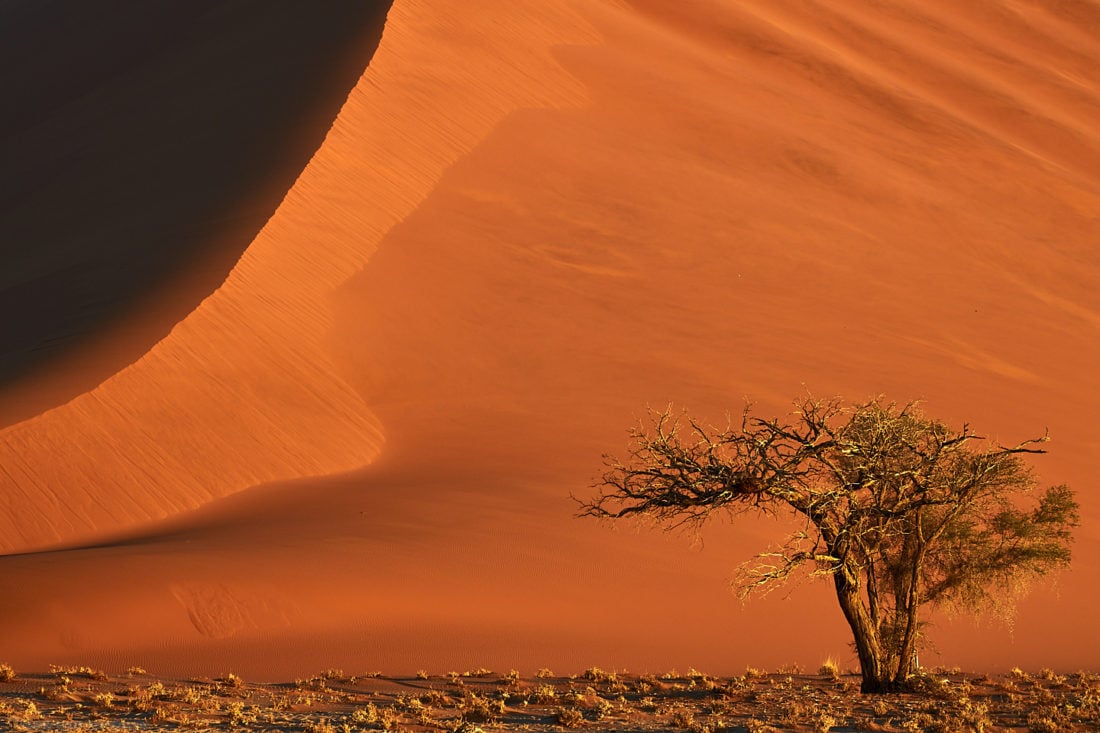
There are actually two Camel Thorn trees in this shot, but I positioned the second behind the one you see here to minimalize the elements in the frame as much as I could. I like to keep things as simple as possible. After this, we walked back to our vehicle, to a Gin and Tonic and some snacks provided by our amazing guide, and then had a nice drive back to the lodge to spend our third night in this very special part of Namibia.
That’s out ten photos for this episode, so we’ll stop there, and pick up the trail again next week as we head over to Walvis Bay where once again the weather gave us an unexpected bonus, enabling us to photograph the flamingos in a beautiful morning mist, so please stay tuned for that.
The Martin Bailey Art Gallery is Live!
Before we finish, I’d like to quickly mention that I have just flicked the switch to go live with a brand new website Martin Bailey Art, which is a new fine art print and wall art store, containing much of my best work, all available to buy as anything from fine art prints, to canvas, metal and even printed onto wood, as well as some budget media, if you’d like to own something but need to keep the price down, although these third party prints are all quite reasonably priced. There is also a 20% discount for first-time orders if you fill out the popup that will display when you first visit, so please take advantage of that if you find something that you like, including many of the photographs that we’ve looked at today. You can find the new site at www.martinbailey.art. I hope you like what you find there! If you are looking for one of my photos that isn’t available, by all means, drop me a line, and I’ll upload it for you to pick up a print.
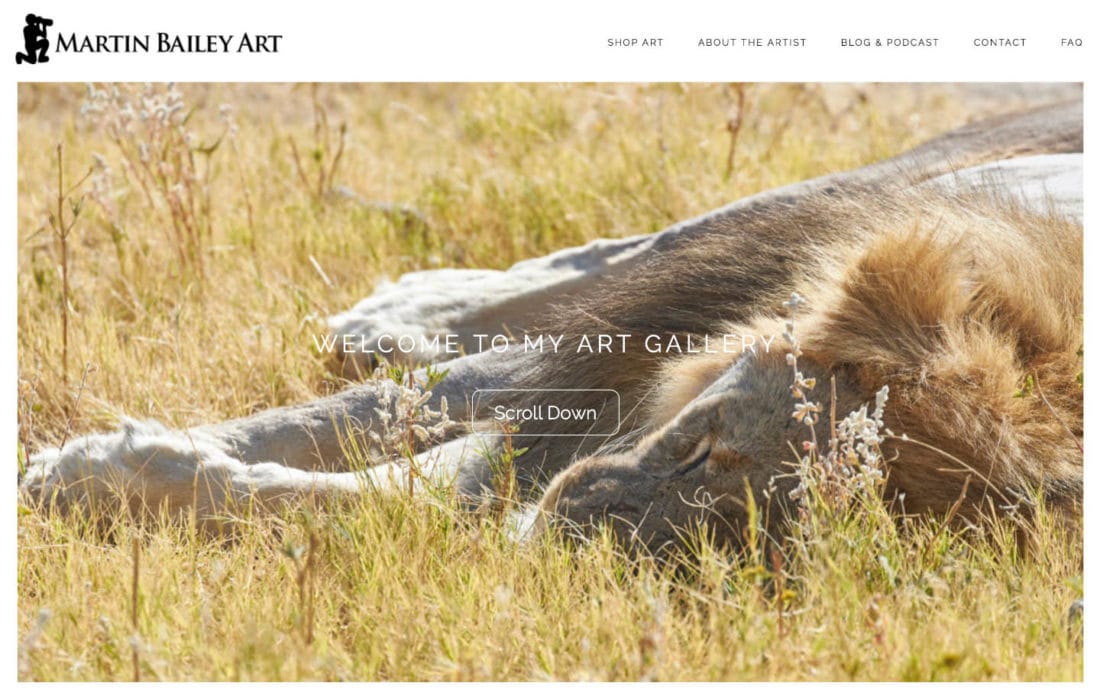
Complete Namibia Tour & Workshops 2020 and 2021
I’d also like to mention that in addition to the places that we have left for my 2020 Complete Namibia Tour & Workshop, I have now started to take bookings for 2021, and you can find details of each tour at https://mbp.ac/namibia2020 and https://mbp.ac/namibia2021 respectively.
Show Notes
Visit Martin Bailey Art here: https://www.martinbailey.art/
See details of currently available Namibia Tours at https://mbp.ac/namibia2020 and https://mbp.ac/namibia2021 respectively.
Audio
Subscribe in iTunes to get Podcasts delivered automatically to your computer.
Download this Podcast as an MP3 with Chapters.
Visit this page for help on how to view the images in MP3 files.

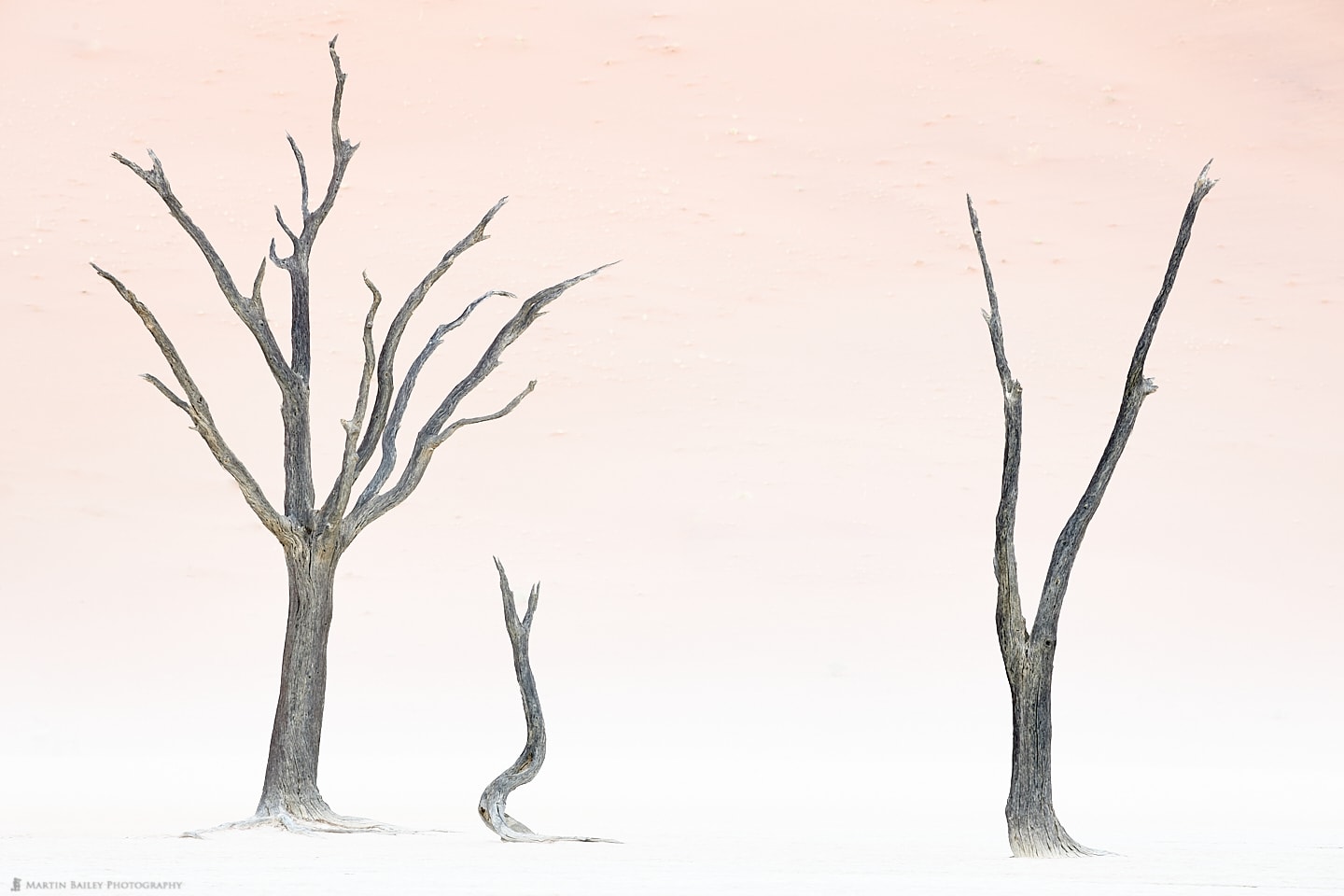
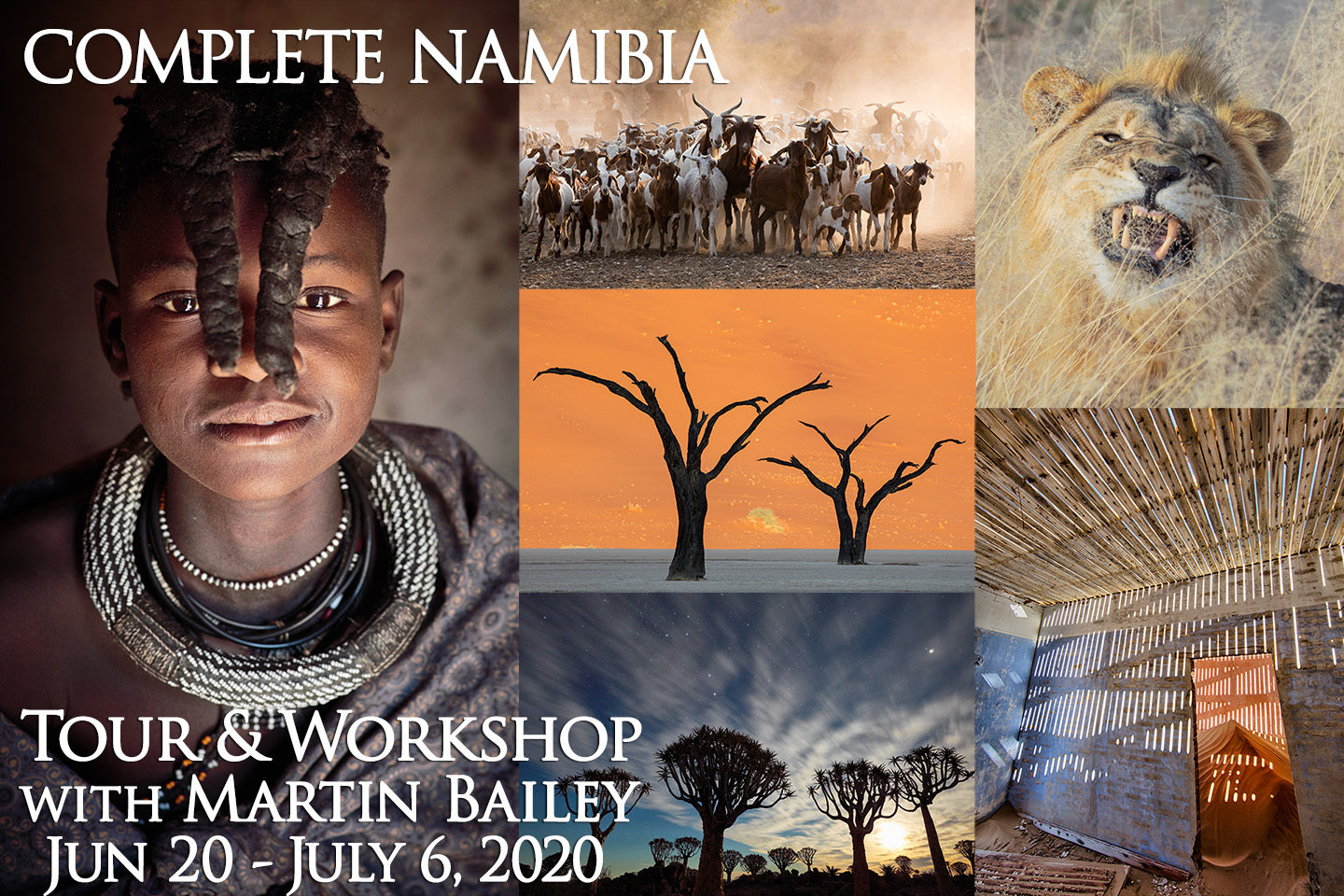


0 Comments